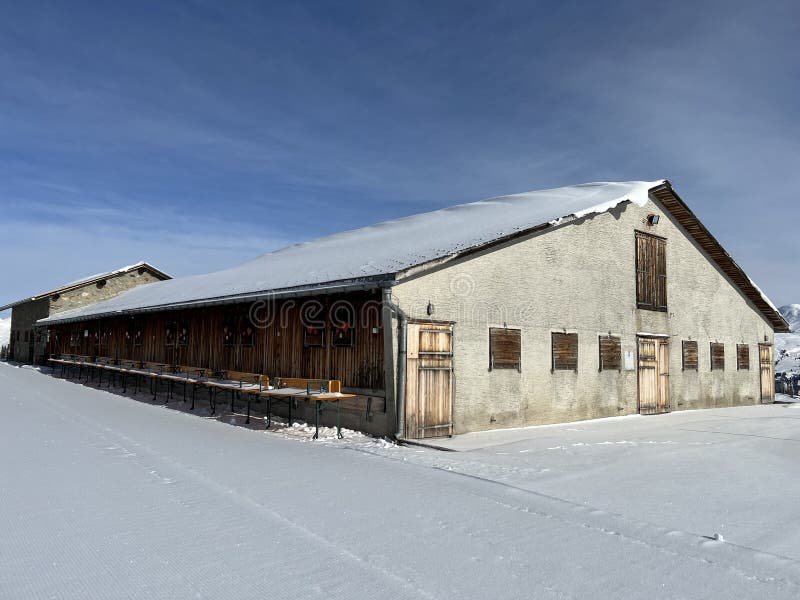Protecting Swiss Alpine Livestock: Evacuation Efforts Following Landslide Warning

Table of Contents
Early Warning Systems and Monitoring
Effective protection of Swiss alpine livestock begins with robust early warning systems. Predicting landslides requires sophisticated monitoring and rapid communication. This involves a combination of advanced technologies and close collaboration between meteorological services and farming communities.
- Seismometers and ground movement sensors: These instruments detect subtle shifts in the earth's surface, providing early indications of potential instability. Sophisticated sensors, often linked to real-time monitoring networks, can alert authorities to impending landslides.
- Real-time weather data analysis: Intense rainfall is a major trigger for landslides. Analyzing real-time weather data, including rainfall intensity and duration, enables prediction of high-risk periods. Advanced weather models are crucial for predicting potential landslide events with increased accuracy.
- Geological mapping identifying high-risk zones: Detailed geological surveys identify areas prone to landslides. This information is vital for developing evacuation plans and prioritizing monitoring efforts in high-risk pastures. Such mapping often uses advanced GIS (Geographic Information System) technologies.
- Collaboration between meteorological services and farming communities: Effective communication is paramount. Collaboration ensures that farmers receive timely warnings and can respond swiftly, protecting their livestock. Regular training and drills reinforce emergency protocols.
The integration of these technologies and collaborative efforts is crucial for enhancing early warning capabilities and ensuring the timely evacuation of livestock before a landslide occurs. Examples include the use of specialized software integrating meteorological data with geological risk assessments, providing farmers with location-specific alerts.
Evacuation Procedures and Best Practices
Once a landslide warning is issued, swift and efficient evacuation procedures are vital for protecting Swiss alpine livestock. The process requires careful planning, trained personnel, and appropriate transportation methods.
- Designated safe zones and evacuation routes: Pre-determined safe zones, away from landslide-prone areas, are essential. Clearly marked evacuation routes, considering the challenging terrain, are crucial for efficient and safe animal relocation.
- Pre-planned transportation methods: The choice of transportation depends on several factors, including terrain accessibility and the type of livestock.
- Trucks and trailers: Suitable for relatively accessible pastures and less steep terrain.
- Helicopters: Necessary for evacuating livestock from remote and inaccessible high-altitude pastures, offering a rapid response in emergencies. This method, however, is often more expensive and requires specialized handling.
- Trained personnel and volunteers: Efficient evacuation relies on well-trained individuals who understand animal handling and emergency procedures. Local volunteers often play a critical role in supporting the evacuation efforts.
- Importance of animal welfare during transportation: Minimizing stress during transportation is critical. This involves using appropriate handling techniques, providing adequate ventilation and space, and ensuring a smooth and safe journey.
Evacuating livestock in the mountainous terrain of the Swiss Alps presents significant challenges. The inaccessibility of some pastures requires specialized techniques and resources, highlighting the need for well-rehearsed evacuation plans and adaptable strategies.
Post-Evacuation Care and Animal Welfare
The well-being of evacuated animals remains a priority after the immediate danger has passed. Comprehensive post-evacuation care ensures the animals' health and facilitates their eventual return to their pastures.
- Temporary shelter and feeding arrangements: Providing adequate shelter, clean water, and appropriate feed is crucial for maintaining animal health and reducing stress.
- Veterinary check-ups and health monitoring: Regular veterinary assessments help identify and address any health issues that may have arisen during the evacuation or due to stress.
- Reintegration strategies back into their pastures: A careful and gradual reintroduction into their original pastures minimizes further stress and ensures a smooth transition.
- Assessing potential long-term impacts on animal health and productivity: Long-term monitoring can help identify any lasting effects on animal health and productivity, informing future preventative measures.
Collaboration between farmers, veterinarians, and government agencies is crucial for ensuring the successful post-evacuation care of the animals and their efficient return to their pastures.
The Role of Insurance and Government Support
Financial protection and government support are essential components of protecting Swiss alpine livestock. Farmers need access to appropriate insurance and government programs to mitigate economic losses resulting from landslides.
- Financial assistance and insurance programs: Agricultural insurance programs, specific to livestock losses due to natural disasters, can help compensate farmers for economic losses caused by landslide-related events. These programs often cover the costs of animal loss, veterinary care, and temporary relocation expenses.
- Government's role in supporting livestock protection initiatives: Government support includes funding for early warning systems, research into landslide prediction, and providing subsidies for infrastructure improvements that reduce the risk of landslides.
- Specific agricultural insurance programs in Switzerland: Switzerland offers various agricultural insurance schemes covering livestock losses due to various events, including natural disasters. These programs often work in collaboration with farmer cooperatives and regional agricultural authorities.
Conclusion
Protecting Swiss alpine livestock from landslides necessitates a comprehensive and integrated approach. By combining advanced early warning systems, efficient evacuation procedures, and thorough post-evacuation care, Switzerland can significantly reduce the risks posed by landslides. This collaborative effort, involving farmers, government agencies, and technological advancements, is crucial for ensuring the safety and economic well-being of the Swiss alpine farming community. Further research and investment in protecting Swiss alpine livestock are vital for securing the future of this crucial industry. Learn more about initiatives designed to protect Swiss alpine livestock and contribute to safeguarding these valuable animals and the livelihoods they represent. Invest in early warning systems and support sustainable farming practices that help mitigate the risk of landslides. Let’s work together to ensure the continued safety and prosperity of Swiss alpine livestock farming.

Featured Posts
-
 Kkr And Rcb Announce Ipl 2025 Player Replacements
May 23, 2025
Kkr And Rcb Announce Ipl 2025 Player Replacements
May 23, 2025 -
 London Calling Grand Ole Oprys Inaugural International Show
May 23, 2025
London Calling Grand Ole Oprys Inaugural International Show
May 23, 2025 -
 Beenie Mans New York It A Stream Strategy A Detailed Look
May 23, 2025
Beenie Mans New York It A Stream Strategy A Detailed Look
May 23, 2025 -
 Kolkata Knight Riders And Royal Challengers Bangalore Ipl 2025 Replacement Players
May 23, 2025
Kolkata Knight Riders And Royal Challengers Bangalore Ipl 2025 Replacement Players
May 23, 2025 -
 England Vs Zimbabwe Test Match Team Revealed
May 23, 2025
England Vs Zimbabwe Test Match Team Revealed
May 23, 2025
Latest Posts
-
 Federal Investigation Office365 Data Breach Nets Millions For Hacker
May 23, 2025
Federal Investigation Office365 Data Breach Nets Millions For Hacker
May 23, 2025 -
 Open Ais 2024 Developer Conference Streamlining Voice Assistant Development
May 23, 2025
Open Ais 2024 Developer Conference Streamlining Voice Assistant Development
May 23, 2025 -
 Millions Stolen Inside The Office365 Executive Inbox Hacking Scheme
May 23, 2025
Millions Stolen Inside The Office365 Executive Inbox Hacking Scheme
May 23, 2025 -
 Exec Office365 Breach Millions Made From Inbox Hacks Fbi Says
May 23, 2025
Exec Office365 Breach Millions Made From Inbox Hacks Fbi Says
May 23, 2025 -
 Open Ais 2024 Event Easier Voice Assistant Creation Tools Unveiled
May 23, 2025
Open Ais 2024 Event Easier Voice Assistant Creation Tools Unveiled
May 23, 2025
